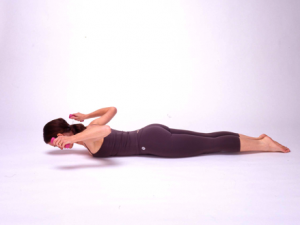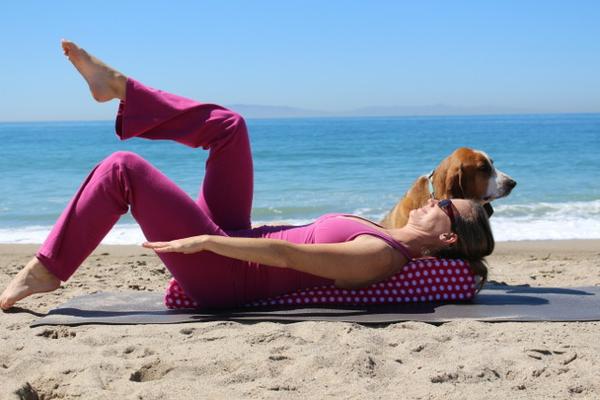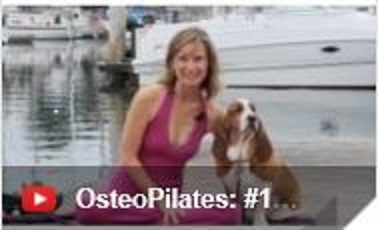Karena Thek is the author of OsteoPilates, Increase Bone Density, Reduce Fracture Risk, Look and Feel Great! (2003, Career Press)
Is Pilates safe for osteoporosis? It can be. If taught with appropriate modifications, Pilates is safe for those with low bone density. In fact, not only is Pilates safe, but it also gives your client her best chance for remaining fracture-free outside of the Pilates studio. And with 50% of all post-menopausal women having low bone density, it is not a condition to be ignored in your Pilates practice.
For our discussion, let’s cover these four areas:
- An impressive study.
- Contraindications for low bone density.
- Modifications in the Pilates environment.
- Safety in the studio; A Great Analogy.
Mayo Clinic Study, 2002.
The Mayo Clinic did a study on the effects of exercise for low bone density that began in 1990. In the study, there was an exercise group and a control group. The control group did no exercise and the exercise group did just one exercise. The exercise looked a lot like swan prep (prone, with the forehead on the hands and the entire upper body lifts off the floor). The biggest difference was that little by little, weight was added along the thoracic spine. Eventually the exercise group was lifting 50 pounds. They did this exercise for 18 months. Then stopped.
Ten years later, the exercise and control groups were brought back in for review. The results showed that the exercise group had a fracture rate that was 300% lower than the control group. That’s significant! The other factor that I find interesting, is that the bone density did not increase for the exercise group. It appears that the increased strength was the protective component for the spine. This is great news!
Contraindications.
When you are working with a client with low bone density (osteoporosis or osteopoenia) you will avoid:
- Spine flexion.
- Hip Abduction.
- Spine Rotation.
- Spine lateral flexion.
Neutral is now your friend. Your best friend. My clients tell me, “But I do spine flexion when I pick up my grandchild or tie my shoe. I rotate when I drive or garden. I abduct to get out of bed in the morning.” Yes, I hear that. But you are with me now for one very short hour. And the exercises that we do tend to be loaded, which means they have weight added to them, either spring weight or our own body weight against gravity. It is my job in one hour to make your neuro-muscular system work in a way that will create maximum results for you when you walk out of the Pilates studio. Improving your spine rotation and flexion, etc, will only put you at increased risk for fracture when you go about your daily life. I want you to be protected when you walk out my door which is why we will focus on strengthening in a way that will fortify your bones, not endanger them.
Applications in the Pilates Studio.
“But I have to teach the Pilates Series of 5, I have to teach Teaser. It’s what the clients want, it’s what my gym wants.” There is nothing that screws me into the ceiling faster than this comment, or some variation thereof. You have a choice of what you teach. You can teach ethically or unethically. If it’s really about the clients, do you think they want a fractured spine? A fractured hip is noticeable but a fractured spine starts out as a nagging dull ache. You can tell me, “I do roll-over and roll-up with my low bone density clients all the time and they’ve never gotten hurt.” Not true. You have hurt them by grooving an unhealthy pattern. And I can also promise you that one day the spine could fracture. And in a heavily loaded position like roll-over and roll-up? It won’t be a dull ache. It will be a significant, painful, slow-to-heal fracture… Oye. Stepping off my soap box.
I agree that it is initially difficult to learn to apply all the modifications for low bone density in the Pilates studio. First you have to be able to spot the exercises that contain the contraindications. Some are easy to spot, like flexion, for example, in the abdominal work. Continuing with the flexion example, where I see instructors having a harder time, is when it doesn’t look like a crunch or a sit-up. Other examples of flexion exercises you’ll want to avoid include Washer Woman, Stomach Massage with a flexed spine, Elephant with a flexed spine, Monkey, Inverted Tendon Stretch on the Chair or Reformer. Keep your critical thinking cap on while assessing all the different exercises you plan on doing with your client.
Safety in the Studio. A Great Analogy.
Think of a wicker chair. You just bought it at the local garden shop and you’ve placed it in your back yard. You also bought a bird feeder that you want to hang from the eaves. Would you stand on your new wicker chair to do that? Sure! It’s brand new! The fibers are flexible and strong. They will move and spring back in response to the pressure of your weight.
Now let’s fast-forward. The same wicker chair has spent the last 5 years in the elements of cold, heat and rain. The fibers are brittle, broken and some are completely missing, leaving big gaps in the weave of the chair. Now you want to take the bird feeder down. Would you stand on the chair? No, of course not. Your foot would go straight through it.
Our bone structure, particularly the areas rich in cancellous bone like the hip, spine and wrists, are very similar to the wicker chair. When the bones are healthy they are spring-like and move with flexibility just like the brand new wicker chair. When the bones are unhealthy, they are brittle, fragile, easily fractured and some of the bony tissue is completely absent, minimizing the strength of the spine. Now think about what you’d like to do with that spine in the Pilates studio to keep it safe. It changes your decision process, doesn’t it?
Learn from my mistakes. I had a woman with low bone density kneeling on a long box. She slipped and hurt her wrist. It didn’t break, Thank God, but it scared me. It could have easily broken. It made me think about all the positions that I put people in to perform exercises. Can they fall, slip or otherwise hurt themselves? Become aware of these situations. The fall, resultant pain and longer than usual healing times due to a low bone density fracture is not worth doing that one exercise. Find something new.
GROW.
There’s nothing like having a client with limitations to improve your teaching. You are forced to think critically, to come up with a solution, and to create something new. These are all strong qualities in a Pilates Instructor. And while it may seem like you are learning something that is only good for one person, I have never learned anything in my Pilates career that didn’t affect how I teach everyone. That’s why I absolutely love what I do. Diving into a topic, like exercising safely for osteoporosis, will not be an isolated bit of information that you will never use again. It will instead allow you to grow all parts of your career. Good luck and please let me know if you have any questions! Karena
Consider adding spine extension exercises similar to what was performed in the Mayo Clinic Study. For this one, I have my clients elongate to neutral while lifting the elbows to gently contract the muscles in the thoracic region. Weights in the hands are an option when your client is ready.
When doing abdominal work, stay in neutral. You can add a challenge in neutral, if you need it, by performing the exercises on a foam roller, a half foam roll or a Core Cubetm. With the Core Cube, there will be a lot more challenge to maintain neutral than on the foam roller. So Choose your prop wisely!
Check out this video where Karena demonstrates appropriate exercises that reduce risk for bone fracture.
 Karena Thek is a Master Pilates Instructor with a passion for managing pathologies in the Pilates setting as well as disseminating information for those who are ready to change. Her work has led her to author, OsteoPilates, Increase Bone Density, Reduce Fracture Risk, Look and Feel Great! (2003) and Scolio-Pilates, Exercise for Scoliosis, A Pro-Active Guide (2011). In addition to her books, she has numerous webinars and free YouTube videos on the topics that she teaches. Karena is the host of a women’s health talk radio show, Alive & Well Radio on AM1220 KHTS. You can listen live from anywhere on the planet at www.hometownstation.com. She previously hosted Pilates for Healthy Bodies on PBS (2009-2011). And when she’s not teaching, writing or thinking about Pilates? You can find her on FaceBook and Twitter posting pics of daily adventures with her partner John and their furry little child, Gus T. Basset Hound.
Karena Thek is a Master Pilates Instructor with a passion for managing pathologies in the Pilates setting as well as disseminating information for those who are ready to change. Her work has led her to author, OsteoPilates, Increase Bone Density, Reduce Fracture Risk, Look and Feel Great! (2003) and Scolio-Pilates, Exercise for Scoliosis, A Pro-Active Guide (2011). In addition to her books, she has numerous webinars and free YouTube videos on the topics that she teaches. Karena is the host of a women’s health talk radio show, Alive & Well Radio on AM1220 KHTS. You can listen live from anywhere on the planet at www.hometownstation.com. She previously hosted Pilates for Healthy Bodies on PBS (2009-2011). And when she’s not teaching, writing or thinking about Pilates? You can find her on FaceBook and Twitter posting pics of daily adventures with her partner John and their furry little child, Gus T. Basset Hound.
Want to know more about Karena? Click here.



